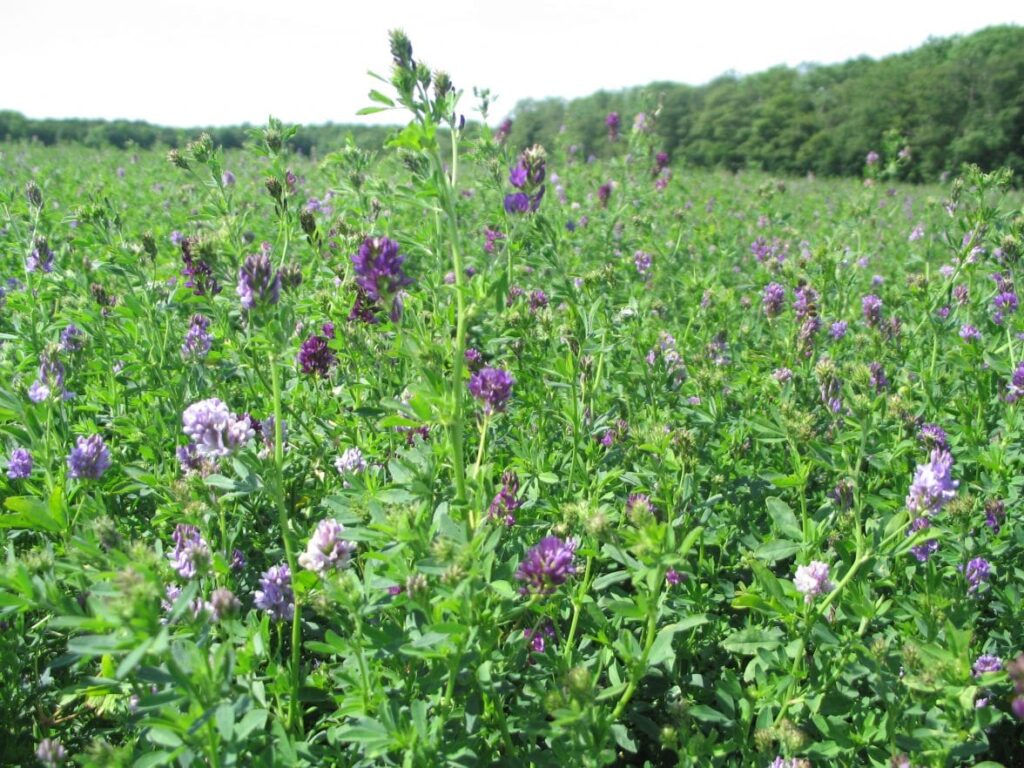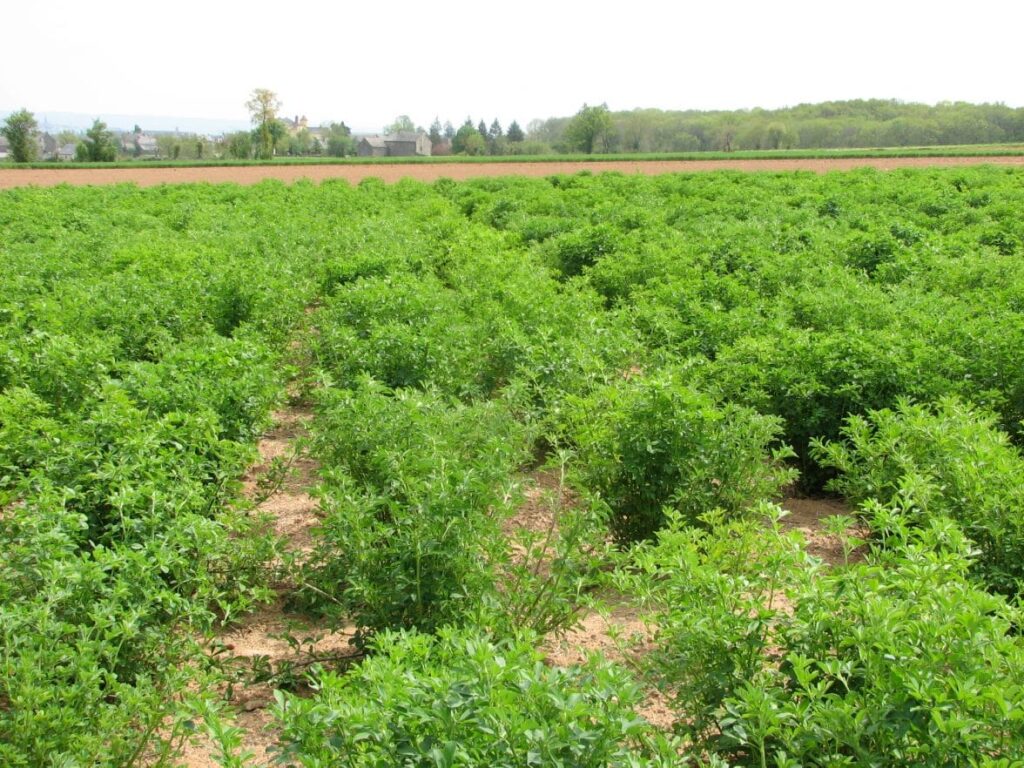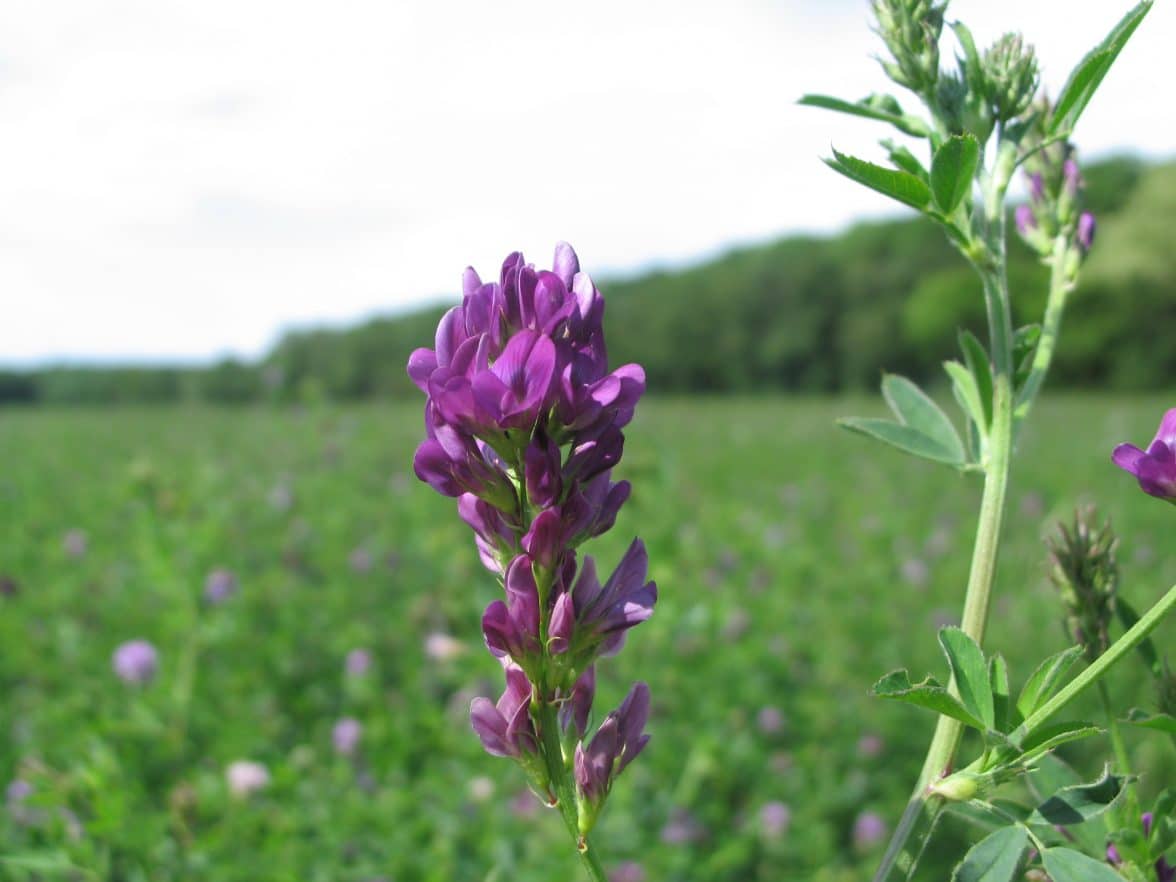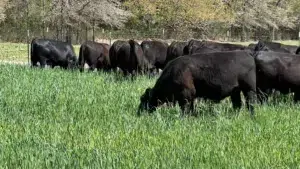A closer look at lucerne breeding
Lucerne, also known as alfalfa, is one of the most cultivated forage crops in the world with a high content of proteins, minerals and vitamins. The global market for lucerne seed is approximately 80,000 tons and it is a major forage crop in many regions of the world; this includes Central Eastern and Southern Europe, Russia, Middle East, China, South Africa, North America, South America and Australia, where lucerne is more drought tolerant than most forage grasses.
The crop is a widely used species for various climatic conditions – from Nordic to hot and dry conditions in the South. Lucerne can be cultivated alone or in mixtures with grasses for silage and hay production. In the past, lucerne was also cultivated for dehydration and pellet production.
Due to a high protein content, lucerne is often mixed with maize and cereals to make balanced protein –sugar rate feeding mixtures. Due to its deep root system (2-20m), lucerne is able to grow in extremely hot and dry conditions as it can make use of soil water in deeper soil layer. In such conditions, it is the main crop for cattle feeding.
Lucerne seed is primarily used for growing animal feed, which is generically referred to as ‘forage’. Seed is planted to produce lucerne that is then used for grazing, “greenchop” (fresh lucerne cut in the field without drying), silage, baled hay, cubes or pellets as a primary food stock for the livestock industry, which includes dairy and beef cattle, horses and sheep.
It is time for European Seed to learn more about this crop, so we sat down with Dan Gardner and Mark Smith of S&W Seed Company, Laurent Guerreiro of RAGT and Vladimir Cernoch of DLF.

Strategic importance
Cernoch mentions that in 2016, DLF succeeded in creating a greater platform in the lucerne seed business. Lucerne is a strategically important high-value crop for co-distribution with forage grass and clover seed in many areas, where DLF strive to develop the seed business. “While DLF has one of the most extensive plant breeding program in grasses, the goal has been to strengthen the activities in lucerne. DLF recently invested in the well-known genepool and the breeding program in lucerne from Florimond Desprez in France.”
Gardner shares that his company provides expertise in agricultural breeding, production and processing for the alfalfa industry. “Each day that passes, two major issues affect the world’s population. First, the population of the world continues to increase and secondly, the availability of arable land continues to decrease. This creates a dire set of circumstances for farmers trying to feed a population increasingly wanting a diet which includes many of the foods that alfalfa hay, the “queen of forages,” supports, including milk, cheeses and beef. Our company is capitalizing on these very important trends to help farmers combat the challenges of today, while keeping an eye on providing sustainable solutions for tomorrow.”
Guerreiro mentions that their lucerne breeding is mainly focused on the French market for which there are two main uses:
a) For direct cattle feeding as hay or silage, in some farms lucerne is also grazed during the summer and autumn. This plant is then used in a pure stand or in a mixture with cocksfoot, most of the time.
b) the second use is mostly located in the North-East of France as production of dehydrated forage (pellets). In that case, lucerne is only established as pure stand crop. In this area lucerne is transformed through dehydration units, the transformed product is then used as component of pigs and chicken diets.
Lucerne adds value to the farm
Farms with a high demand for protein rich feed can become more self-sufficient by growing lucerne. Sowing a field of lucerne helps to reduce the costs for external protein sources and dependency on fluctuating world market prices, leading to improved economy. Cernoch says: “One field of lucerne will generate more than 3.000 kg protein/ha due to its high content of protein (18-20%), compared to forage grass (14%), maize (9%) or soya (1.200 kg protein/ha). In addition to high protein content and better self-sufficiency, lucerne is also an excellent mixture component with grasses and an excellent complement to maize in the feed recipes. Finally, the crop is easy to establish and saves input cost on fertilizers.”
Breeding targets
Gardner indicates that for more than 35 years, S&W Seed Company has bred lucerne varieties of the highest quality with superior genetic traits, the unique ability to grow in challenging soil conditions and to generate outstanding crop yield. “Our specialty is high-yield, non-dormant alfalfa varieties focused on maximizing profit per acre for the farmer, regardless of soil and water salinity.”
According to Guerreiro, the breeding objectives are somewhat similar for the two main uses: forage and cover crop. “They are yield level, feeding value elements (protein content and digestibility), resistance to lodging (especially for dry areas) and disease resistance, which would be first nematodes, secondly Verticillium and Colletotrichum fungi. There is additional interest on persistency especially under tough climatic conditions (winter, drought)” he adds.
Yield increase
Cernoch mentions that similar to most other agricultural crops, dry matter (DM) yield is the main breeding goal. “Very often DM yield depends on disease resistance, which can be a limiting factor for yield. In addition to DM yield, important breeding tasks are feeding quality like protein content and cell fiber digestibility, lodging, seed production and others. “
Guerreiro mentions that the biggest challenge in lucerne, like for other perennial forage species used as food for animals, is to keep a very good yield level while improving feeding value, disease tolerance and lodging resistance. “Our main source of material for our new creation is essentially our gene pool that we improve as the number of breeding cycles progresses. It is also possible to enrich the gene pool with competitor varieties. The genetic progress regarding yield is sometimes considered as low compared to other crops, which is probably true. Improvement of this species in the last 20 years was clearly made on several other criteria along with a small increase of yield level. Protein content and disease resistance are probably the most visible at the end-users level” he says.
Gardner adds that S&W are actively breeding in the US and the rest of the world for a variety of traits. “We are best known for our salt tolerant lines that are the most tolerant lines in the world. These varieties that are developed for salt tolerance are subjected to soils within the root zone with water having salinity levels of up to EC 15. This would be the equivalent of irrigating with water having an EC value of 10. Several of our alfalfa varieties are currently marketed as salt tolerant varieties, and are also very productive in soils without salt problems. United States Department of Agriculture (USDA) and University of California researchers tested one of our varieties in well drained sand tanks at the salinity laboratory in Riverside in 2001 using irrigation nutrient solutions with EC 15 and EC 25. With a 275 day growing period, this variety yielded 11.5 tons/acre with EC 15 solution and 6 tons/acre with EC 25 solution. So it shows that selective breeding of alfalfa varieties for salt tolerance does work! SW 9215 and SW 8421S have at least as much salt tolerance as SW 9720.”
“Besides all other breeding targets, we should not forget about seed yield, which is also a key point to achieve in the commercial development of a variety. Each time when possible in the various breeding steps, the best seed yielders are chosen” says Guerreiro.

Regional differences
Lucerne is produced under various climatic conditions. One of the most important traits for lucerne varieties is fall dormancy, i.e. the ability to stop growth before winter. Varieties with strong fall dormancy are mainly suited in the Nordic conditions, where it is necessary to stop growth before winter in order to survive. At the other extreme, in Southern conditions varieties with strong winter growth are asked for, as these lucerne cultivars have a higher yield productivity in mild winters compare to dry and hot summer. The US fall dormancy scale has a range from 1 -11:
- FD 1-2 covers varieties with very strong fall dormancy used mainly in Nordic and continental conditions
- FD 3-5 are varieties used for example in West & Central Europe and the European part of Russia
- FD 6-8 are semi dormant varieties mostly for the Southern part of Europe
- FD 9-11 are non-dormant varieties suited for the Mediterranean region, North Africa, and other areas in the Southern hemisphere.
Cernoch indicates that DLF is conducting a range of national variety trials in many countries across Europe. “In the current research program, the main germplasm comes from varieties with a dormancy score in the range four to five. This is the most common type used across much of Central, Eastern and Northern Europe.”
In France the market is almost exclusively composed of dormancy from 4.5 to 6, with a small use of Mediterranean type in south of France says Guerreiro. “The main use is really around forage, and for the moment, the use as cover crop is very limited”. Gardner: “The climate in the western U.S., where a majority of our company’s production is located, is ideally suited for high-quality alfalfa seed production.”
Does each region require its own varieties?
Cernoch underlines that apart from climatic conditions, the development of new varieties is under influence by farmers requests for quality. “For example, in Central, Eastern and Southern Europe, farmer’s priority is DM yield and lodging resistance (standability), as the first cut is carried out just before flowering. DM yield and lodging resistance here are the main traits for variety registration.” He adds “Western European farmers are also looking for DM yield and lodging, but feeding quality issues like protein content and fiber digestibility are important too. US and Canadian farmers prefer high cell wall digestibility with low lignin content, and therefore North American varieties are less lodging resistant. That is one of the main reasons, why overseas varieties often have registration-problems in Europe.”
Pests and diseases affecting lucerne
Pests and diseases can drastically affect DM yield and persistency of lucerne. Guerreiro says “We didn’t see any new diseases appear in the past years. On the contrary, we are seeing a decrease of the intensity of symptom of nematodes or Verticillium in farmers’ fields, probably due to the generalization of the use of resistant varieties.” Cernoch adds that diseases have a different importance in various regions. “The most important diseases and pests are Verticillium, Colletotrichum (anthracnose) and stem nematodes. Breeding for resistance to these problems are important tasks for all plant breeders.“
Creating a new lucerne variety
Plant breeders need to combine a variety of traits. “We need fall dormancy, DM yield, feeding quality, disease resistance and seed yield. In our global breeding and testing network, DLF is developing, screening and selecting lucerne germplasm derived from different sources across the world to develop the most suitable varieties according to climatic and management demands for the single regions” says Cernoch. “DLF’s lucerne breeding program operates across Europe and around the world. We are looking to develop varieties that offer higher yields, better disease resistance and stronger winter hardiness,” he adds.
“It is particularly difficult to use the new technology base, such as markers, due the genetic structure of this legume. Lucerne is autotetraploid and most of the created varieties are synthetic populations which make the molecular analysis much more complex as compared to other crops” says Guerreiro. “However, recently a certain technological obstacle has been unlocked and we can now imagine that technology such as genomic selection could be a new tool for breeding lucerne. However, before introducing this kind of technology in the general process of breeding, the challenge will be to find a valuable economic model” he adds.
Smith states “I am happy to say that S&W Seed has full capabilities in all facets of alfalfa breeding. We have two greenhouse complexes screening and characterizing 20-plus pests of alfalfa, which includes diseases, insects, and nematodes. Also we have an NIR lab characterizing forage quality and a molecular lab working on markers and new trait development. In addition, our company has research facilities in Australia and the US with collaborations and partnerships in Europe and other areas of the globe allowing us to move quickly to address grower concerns and needs for all dormancy’s.”
“Breeding duration can be very long as for every other perennial forage species; a cycle of improvement lasts at least 10 to 12 years, to which we have to add 3 or 4 years to pass on the registration step in France or in other European countries” underlines Guerreiro. “Even if we follow very precise breeding targets we always try to keep a good variability in our gene pool, to be able to address a new need if necessary. We try to keep informed about the new technologies or new potential by collecting bibliographic references and keeping in touch with our colleagues who are in contact with final users.”
What’s in the pipeline?
“We also have an ETS approved transgenic program, a gene editing / NBT program, as well as a broad conventional breeding program.” says Gardner. “Our European program focuses on lodging tolerance and forage quality. And we are currently using marker assisted selection and utilizing advance statistical designs on a regular basis.”
Cernoch mentions that their new breeding program offers commercial varieties that are recommended for both forage and dehydration on the official GEVES list in France. “The varieties provide top yield, high protein, good lodging resistance and improved pest and disease tolerance. DLF also offers specialised lucerne varieties with good features in yield and establishment under sub-optimal conditions, allowing growth of lucerne on soils where it usually does not belong“.
As a legume, alfalfa can satisfy its nitrogen needs through a naturally occurring symbiotic relationship with bacteria called rhizobia in the soil. This invaluable trait removes the need to use additional nitrogen fertilizer inputs to support plant growth. Recent research is trying to unlock this species’ genome. Understanding the genome sequence could lead to alfalfa plants with increased ability to survive in stressful environments such as drought and animal grazing. It could also produce higher biomass yields when baled as hay, extend its growing season, and adapt better to different soil types and nutrient levels.
Where on the web: Background information on the initial Medicago truncatula research is available at http://www.noble.org/Global/news/annualreport/2011/annualreport.pdf












